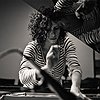Round Table Participants: Magda Mayas, Ute Wassermann
Occupations: Composers, improvisers, vocalist (Ute Wassermann), pianist (Magda Mayas)
Nationalities: German
Current release: Magda Mayas and Ute Wassermann are part of the collective Smallest Functional Unit which has published the first issue of Graphème - a Publication for Experimental Musical Scores. The goal of SFU and Graphème is to draw attention to how notation influences performance and how new notational concepts can lead to surprising, inspiring and forward-thinking results. Or, as the official mission statement puts it: “The dominant, traditional, Western notation is only one aspect among many forms of expression in the field. We are interested in unconventional notational formats and graphic scores, as these represent visions of sound that are open to diverse, idiosyncratic ways of interpreting and working. Works in which improvisation, composition, interpretation, performance and sound art merge require relevant modes of representation.“
Smallest Functional Unit further consists of Tony Buck, Mazen Kerbaj, and Racha Gharbieh. Beside them, the first issue of Graphème contains contributions by Tomomi Adachi, Lotta Anker, Lloyd Swanton (of The Necks), Marina Cyrino, Tina Douglas, Phill Niblock, Jon Rose, and Nate Wooley.
[Read our Magda Mayas interview]
[Read our Tony Buck interview]
[Read our Tina Douglas interview]
[Read our Jon Rose interview]
If you would like to find out even more about Smallest Functional Unit and Graphème, visit their bandcamp page.
Scores are one way of passing on music from one generation to the next – the oral tradition and recordings being the other one. What are the main benefits of scores from your point of view compared to the other two?
Magda: Each method has its advantages and disadvantages depending on the cultural context and musical genre and also on the purpose of “capturing music” through these different media - whether it is a document of a piece being performed, a concert, or an instruction for someone else to play the composition.
Some methods are not appropriate for certain styles of music - a blues e.g. can only be captured in a score in a very limited way and conveys its meaning much better through a recording or oral tradition, while an orchestral classical piece is maybe most appropriately represented through a score.
Recordings are more static of course, but can capture or document (with all the limitations and possibilities integral to technology) and provide the listener with one version of a piece, at a certain time and place.
Scores can leave more room for individual interpretation and imagination, and can be quite precisely notated in some ways (mostly relating to pitch and rhythm). But at the same time it's always somewhat metaphorical and requires translation from another medium (back to) sound.
Ute : These are not benefits - because we are talking about three different things.
A graphic score visually presents an idea or a concept. The music is imagined in the mind of the viewer. It is expressed through a performance. In some cases the graphic score is a visual work of art as well as a notation. A graphic score takes into account the sound language and the experience of the specific performer. This way the boundaries of composition and interpretation blur.
The way of interpretation will change significantly if the score is passed through generations. On the one hand, a historical graphic score can be interpreted in a contemporary way, or on the other hand the interpretation preserves the historical context as much as possible.
What are, to you, the limitations of the Western notation system – and when was the first time you concretely became aware of alternatives?
Magda: The traditional Western notation system has a very limited way of notating timbre - it’s generally very pitch oriented. Timbre, even dynamics are quite vaguely notated, there is also not much space for gesture or physicality as such - all aspects which are very important to me and my music making.
Spending a lot of time playing inside the piano, the Western notational systems as a way to notate my music didn’t interest me very much because of the reasons mentioned above - however, I was often fascinated by composers writing for inside or prepared piano who invented their own notational signs additionally to the traditional notation, like Lachenmann, George Crumb or Christian Wolff. I guess that is also when I first became aware of alternatives, during my studies 20 years ago.
I have only started notating music in the last few years really, so its relatively recent. Personally, I find audio scores or photo scores interesting and started using these or graphic elements or text recently.
Ute: The Western notation system fits the purpose of composers and musicians, ensembles and orchestras trained in the academic Western music system. In this context new-music-composers have found very precise ways to notate complex timbres, time structures or gestures. Usually there is a hierarchy between the composer as an inventor and interpreter. This system is not suitable enough for the works of composer performers, improvisors or artists with a different artistic background.
A graphic score gives freedom to the interpreter to expand and explore the own sound language in relation to the score. It blurs the boundaries between composition, interpretation and improvisation. It blurs the hierarchy of the interpreter and the composer.
I have been aware of different ways of notating sounds at a young age. At age 5 I learned the classical Western notation. But even younger I would look with my father at the picture stories of Wilhelm Busch. I found it exciting that these drawings visualised sounds and gestures. A few years later I have been to places like the caves of Lascaux: action and sound paintings!
As a student at Art school I made my own graphic scores and drawings and I collaborated with artists from Fluxus movement and composers like John Cage, Henning Christiansen or Phil Corner. The use of graphic scores was the best way to express artistic ideas.
I'm curious about your take on the psychological impact of the Western system. Most artists I talk to tend to see one of the most important traits of music in its ability to express emotions. At the same time, traditional scores “capture” these emotions with entirely abstract symbols. Do you see this as a problem or perhaps as a benefit?
Magda : I think emotion is only one thing music can trigger - but sometimes it is about showing a certain perspective or idea which can also be quite intellectual, or part of a mindset, apart from it being about emotional expression.
However, all these things you mention are abstract - sound, emotions, graphic symbols. I don’t see that as problematic, a score is always a translation from one medium to another, whether one uses the Western traditional system or anything else.
I think the symbols and graphics in the Western notational system are really about precision in pitch, rhythm and articulation - to convey the composer’s ideas in these parameters as closely as possible. I guess with it comes the idea or ideal to be able to “conserve” and repeat an idea in the very same way every time - and these parameters - pitch, rhythm, articulation - can be notated and captured and played and repeated quite precisely. So that is definitely a benefit of the system and its symbols.
Some compositions and musical ideas are not about the actual musical material though - but about the process or the way it is performed - which makes notating or capturing it more difficult I think and even more abstract.
Ute: Every form of notation only becomes music through the translation of the performer, may it be abstract or not. I see no problem in using abstract symbols to express emotions - if the expression of emotions is to be the main focus at all.
Personally I don´t see the most important traits of music in its ability to express emotions.
From the past, what were some of the most convincing graphic scores you've seen or performed? What did working with them feel like and how did it affect the process of music making?
Ute: The scores of Hans-Joachim Hespos are visually very expressive. and very precise. He invents his own expressions and a wide range of graphic symbols in order to describe timbres, sound gestures or time processes. He finds a unique way of melting traditional notation with graphic notation. The perfomer is like walking a tightrope, balancing between freedom and precision.
Henning Christiansen notations are drawings, texts and scores at the same time. They are poetic and political. In Henning's words: Freedom is around the corner!
What's your take on the idea that graphical scores are works of art in their own right – can they be? Should they be? Shouldn't they?
Ute: Not always. Only if the visualisation is so convincing that it can do without music. There is no should or shouldn’t.
Magda: They certainly don’t have to be. I think that's hard to generalise and is really in the eye of the beholder. We have one score in the first edition from Tina Douglas e.g. who is primarily, but not only, a visual artist. She made the piece as a musical score and with the intention of the piece being performed and sounding. For me it is also a work of art in its own right.
Graphème is supposed to be an ongoing project. Tell me a bit about what you still want to achieve and what some of your upcoming activities will be.
Ute: Graphème wants to strengthen the international community of composer performers and artists. We want to show the big variety of graphic notation and focus on specific topics as well.
Magda: Graphème will publish further editions, aiming to represent a wide range of international artists with diverse backgrounds and approaches. We might have different topics and themes in the future - e.g. dealing with site specificity, geographical focus, haptic scores or other ideas.
Furthermore, we are planning to perform the scores and invite composers to discuss their works, give talks or even workshops in form of a festival. This depends on the funding we can secure, but so far, the first edition was received very well so we are planning a second edition in 2022.





